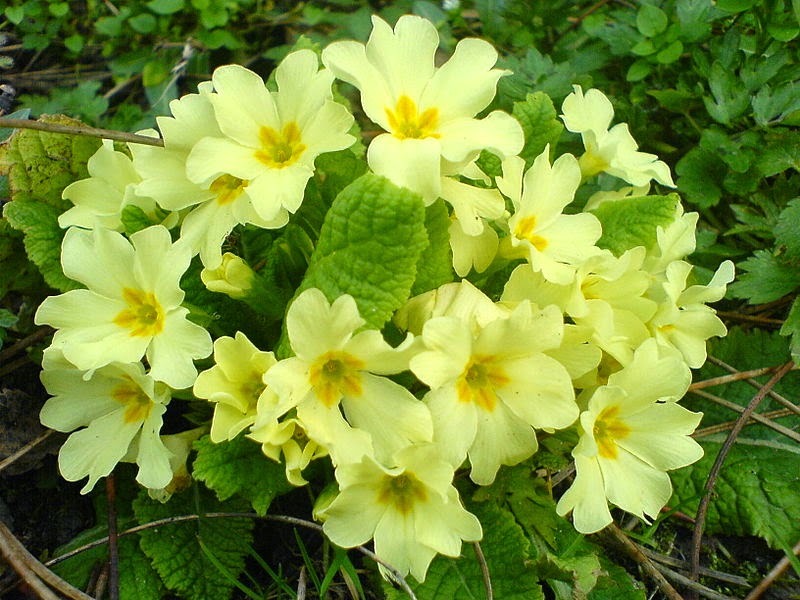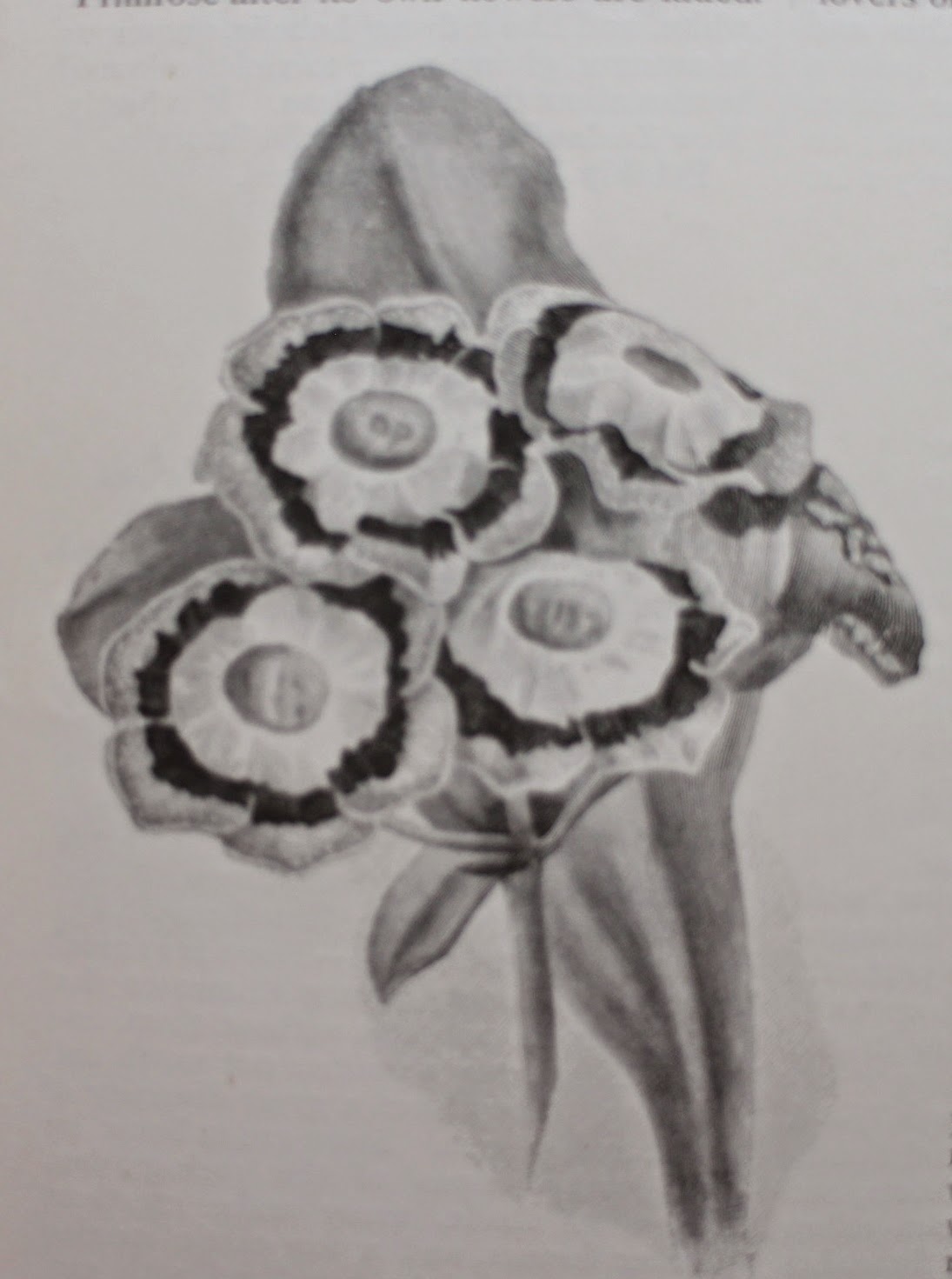 |
| The wild primrose - Primula Vulgaris @ Creative Commons |
Firstly there is a sigh of relief as the Xmas holiday and New Year flash past, my mind immediately turns to the soil warming up and the flowers that will appear, already there is a little primrose flowering in its pot, the delicate petals lined with dark undertones. My mind goes back to the bank of primroses at the old garden, buried deep in the grass their pale lemon petals so delicate, like a delicious confectionery. My mind dwelt on the fact that we call these fragile flowers primula vulgaris, and noting that the Latin use of the word gives this most beautiful plant a rather dismissive title I turn to W Robinson - The English Flower Garden 1895 to see what he says..
"Of all the Primula family, none excel our native Primroses in loveliness, and they are the earliest of all to flower. The Gentian and the dwarf Primulas do no more for the Alps than these charming wild flowers do for our hedgerows, banks, groves open woods"....
But of course there is so much more to this wide ranging family of plants, than the rather badly coloured primroses we find in the supermarket. I can remember a visit to Forde Abbey in Dorset many years ago and coming across the Candelabra Primulas and immediately falling in love with their delicate shades of pink, ( which is I believe P.Sikkimensia) lining the banks of the pool there, here on what must have been slightly acid soil rhodendrons and azealas formed the background to this old abbey and also meeting for the first time the exquisite blue Himalayan poppy.
But returning to primulas their range is vast, from the Alps of Switzerland, to the Primula Sieboldi that had come from Japan. Or the Auricula, those creatures of a farinaceous nature of the petals (which means the floury nature), and for this description once more Robinson on the subject of these "florist flowers" is apt...
"The florists' favourites are distinguished by the dense mealy matter with which the parts of the flower are covered
they are divided by florists into four sections - green edged, gray edged,, white edged and selfs. In the green-edged varieties the 'gorge' or the throat of the flower is usually yellow or yellowish; this is surrounded by a ring varying in width, of white powdery matter, which is surrounded by a ring of some dark colour and beyond this is a green edge..."
Not a very good photo I shall try this year to scan more on the printer.
If I was to fulfil one New Resolution of this year it would be for a 'cupboard' in the garden to house auriculas, they need cover from the rain but also need to be out in the cold. Alongside them would be a blue double petalled primrose, which I have always wanted, they are sterile as far as raising seeds from them are concerned and are propagated by division of the plant.
And where do you get these plants, well there will some in your local nursery, but the ones to fall in love with are at Barnhaven in France, these famous strains of primulas have a history of their own. Starting early in the 20th century in America, they eventually migrated to England and another nursery in the Lake District, when the owners retired and the fate of the beautiful Barnhaven plants were in peril once more, they were rescued by a couple in France and there they are at the moment. Losing words like losing plants is a terrible fate, for by doing so we forget history and reduce our sense of the world as an ever expanding knowledge of curious facts....
 |
| Photo @ Forde Abbey |
But returning to primulas their range is vast, from the Alps of Switzerland, to the Primula Sieboldi that had come from Japan. Or the Auricula, those creatures of a farinaceous nature of the petals (which means the floury nature), and for this description once more Robinson on the subject of these "florist flowers" is apt...
"The florists' favourites are distinguished by the dense mealy matter with which the parts of the flower are covered
they are divided by florists into four sections - green edged, gray edged,, white edged and selfs. In the green-edged varieties the 'gorge' or the throat of the flower is usually yellow or yellowish; this is surrounded by a ring varying in width, of white powdery matter, which is surrounded by a ring of some dark colour and beyond this is a green edge..."
 |
| Auricala, Mrs.Moore |
If I was to fulfil one New Resolution of this year it would be for a 'cupboard' in the garden to house auriculas, they need cover from the rain but also need to be out in the cold. Alongside them would be a blue double petalled primrose, which I have always wanted, they are sterile as far as raising seeds from them are concerned and are propagated by division of the plant.
And where do you get these plants, well there will some in your local nursery, but the ones to fall in love with are at Barnhaven in France, these famous strains of primulas have a history of their own. Starting early in the 20th century in America, they eventually migrated to England and another nursery in the Lake District, when the owners retired and the fate of the beautiful Barnhaven plants were in peril once more, they were rescued by a couple in France and there they are at the moment. Losing words like losing plants is a terrible fate, for by doing so we forget history and reduce our sense of the world as an ever expanding knowledge of curious facts....


The farmer's cousin, who lives in our village, grows primulas and has quite a few already in flower in the tubs around his front door (sheltered and facing due south) - they certainly cheer one up this time of year.
ReplyDeleteYes I need to get out to a nursery and plant some primulas as well.
DeleteHappy New year to you both. I saw one flower on a Primrose along Colomendy Hill the 2nd week of December. It's a warm bank and some plants have flowered at Christmas before.
ReplyDeleteI have Auriculas (in my cold frame right now) and one of those has also been flowering right through December. Such lovely things.
Happy New Year to you and your family as well Jennie and may it be a fruitful year in house selling for you and us! I shall have to start collecting auriculas soon, meant to start collecting the sweet smelling geraniums last year which I never did...
ReplyDeleteHoorah - your pictures are BIG! So lovely to see them properly. Not a whiff of Primulas here yet. Happy New Year. Any sign of Moss yet???
ReplyDeleteHi Em, No not yet, a bit worrying, but it is the holiday, so tomorrow maybe, we have already had one parcel lost. Anyway will get in touch when it arrives. Happy New Year to all of you as well.
ReplyDelete